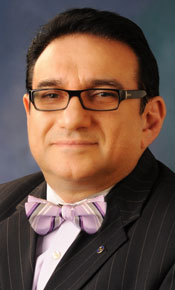
Lake Erie may be experiencing some of the worst levels of pollution it has seen since the 1960s, but a regional director of the International Joint Commission is confident that science will be able to turn that trend around by recommending action needed to restore it to a healthier state.
Best management practices — including better farming methods, wiser use of fertilizers, reducing untreated  sewage discharge and improving municipal waste water treatment processes — are just a few ways to decrease our environmental impact on the lake, according to Saad Jasim, director of the IJC’s Great Lakes regional office.
sewage discharge and improving municipal waste water treatment processes — are just a few ways to decrease our environmental impact on the lake, according to Saad Jasim, director of the IJC’s Great Lakes regional office.
That’s the message he will deliver when he appears as one of four keynote speakers at the annual conference of the Canadian Science Writers’ Association, being held in Windsor, June 2 to 5.
In an advance interview, Dr. Jasim said one of Lake Erie’s greatest challenges is the increased amount of algae in it, caused largely by fertilizers used by the farming community and sewage overflow from municipal and industrial sources. Runoff from farms, for example, laced with those phosphorous fertilizers, is being washed into the lake by increased rainfall, providing food for increased amounts of algae. Farmers need to employ more strategic use of fertilizers in order to reduce their imprint on the lake, he said.
“It impacts them as well, because they use that water for irrigation and drinking,” Dr. Jasim said. “It impacts everybody. We all have a stake in it.”
Jasim said he’ll also address the issue of increased levels of pharmaceuticals and personal care products and endocrine disrupting compounds making their way into the water because conventional municipal water treatment plants are not fully equipped to deal with them.
Municipalities need to consider advanced treatment technologies such as ozone as a way of removing harmful chemicals in their waste water treatment systems before they can make their way back into tap water. Studies indicate that activated carbon and ozone are promising treatment methods to remove traces of pharmaceuticals and pesticides, Jasim said.
The Windsor Utilities Commission evaluated the occurrence of pharmaceuticals and endocrine disrupting chemicals in its raw water supply, and the effectiveness of ozone in removing them. The analysis indicated that trace levels of compounds such as carbamazepine, caffeine, cotinine, and atrazine were detected in raw water and that treatment with ozone was more effective at removing them than conventional methods. While director of water quality and production for the Windsor Utilities Commission, Jasim proposed and successfully implemented ozone for drinking water treatment here.
Jasim also studied the effects of an advanced oxidation process on Lake Huron water and found that it was found to be very efficient in removing both types of contaminants; in fact, five of nine compounds were not detected in filtered water. The results show that the process has a great potential for the treatment of trace contamination of pharmaceuticals in the Great Lakes region, he said.
Jasim brings a wealth of experience to the conference. He earned a PhD in chemical engineering from the University of Wales and was the founding CEO of the Walkerton Clean Water Centre, where he played a major role in establishing it as a leader in the drinking water industry for training, education and research. He is currently an adjunct professor at both UWindsor and Western University.
